Time To Bond
Posted On Monday, Feb 19, 2024
Bonds have had a good start in 2024 so far. Market sentiment is upbeat on the back of falling inflation and the expectation of rate cuts by the RBI. It is also supported by robust demand for Indian government bonds from both domestic and foreign investors.
Foreign demand for Indian bonds has picked up meaningfully since the announcement of India’s inclusion in the global bond Indices in September 2023. Foreign portfolio investors (FPIs) have bought over USD 7.8 billion of Indian government bonds under the fully accessible route (FAR) since the announcement. (as per FPI holding data upto February 14, 2024)
Chart – I: Foreign Investors stepped up buying of Indian government bonds under FAR
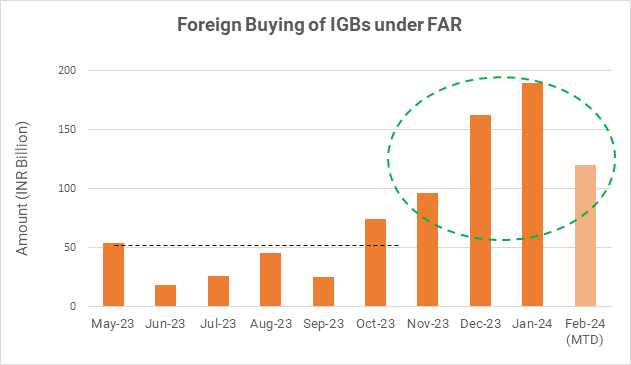
Source - CCIL, Quantum Research; Data upto February 14, 2024
@ February - 2024 data is only upto Feb 14, 2024.
#Under Fully Accessible route (FAR), foreign investors can invest in Eligible Indian government securities without any ceilings.
To recall, Indian government bonds (IGBs) are set to be included in the JP Morgan GBI EM index starting June 2024. To start with, India will get a 1% weight in the index which will be increased by 1% every month until it gets to the maximum assigned weightage of 10% of the Index.
Another global index provider Bloomberg is also in the process of adding Indian government bonds into the Bloomberg Emerging Market Local Currency Index. The potential inclusion is planned to start from September 2024 after an approval from their index advisory committee.
Indian bonds are grossly under-owned by foreign investors with less than 2% of total outstanding government bonds held by foreign investors as per the latest available ownership data for September 2024. This is significantly lower than most of the emerging markets where foreigners own more than 10% of the local bond market.
Chart – II: Indian Bonds are under-owned by foreign investors.
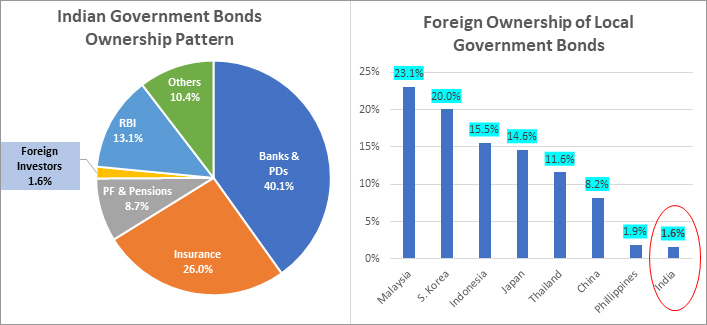
Source- RBI, Asia Bond Monitor, Quantum Research; Data upto September 2023
Given the Indian bonds’ low foreign ownership, the index inclusion should attract sizeable foreign inflows into the Indian bond markets from investors tracking these indices. It is expected to attract around USD 25-30 billion over the next 10-12 months.
Fiscal tightening and reducing bond supply
The FPI demand is picking up at a time when the government is planning to reduce its fiscal deficit and market borrowings. Consequently, the supply of government bonds is expected to decline over the next two financial years.
In the interim budget on February 1, 2024, the government pegged the fiscal deficit for fiscal year ending March 2025 (FY25) at 5.1% of GDP, lower than revised deficit estimate of 5.8% of GDP in FY24. They also reiterated the commitment to bring down the fiscal deficit below 4.5% of GDP by FY26.
Government’s gross market borrowing in FY25 is estimated to be Rs. 14.1 trillion. This will be Rs. 1.3 trillion or 8.4% lower than the market borrowing in FY24. If government continues with the fiscal consolidation, which seems highly likely, government bond issuances will decline further in FY26.
Falling bond supply and strong demand for bonds should bode well for the fixed income market. Longer maturity bonds will likely benefit most from the favorable demand supply mix.
Chart – III: Fiscal consolidation to reduce bond supply
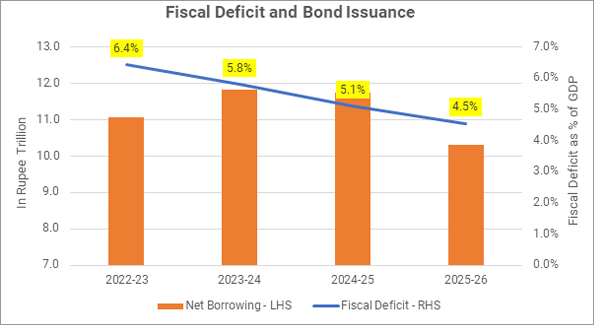
Source – IndianBudget.gov.in, Quantum Research
Data for FY26 is based on Quantum Research team’s estimates
RBI’s Push Back
Amongst many positives for market, the bond street was also expecting the RBI to soften its tone on inflation and provide durable liquidity to ease pressure in the money markets.
The RBI pushed back on this demand. It maintained the policy stance as “withdrawal of accommodation” stating that the inflation is far from its 4% goal and monetary transmission is incomplete in the credit market.
Earlier, the RBI used to link its policy stance with the real policy rates (repo rate minus the CPI inflation) and liquidity condition. So, the new interpretation of the “withdrawal of accommodation” stance is starkly different from our earlier understanding. Having said that, real interest rates are positive and reasonably high, and liquidity condition has tightened meaningfully since the RBI started its rate hiking cycle. Hence, there was a strong case for the RBI to change its stance to “neutral”.
Chart – IV: Real Repo Rate is near 2% - presenting case for Rate Cuts
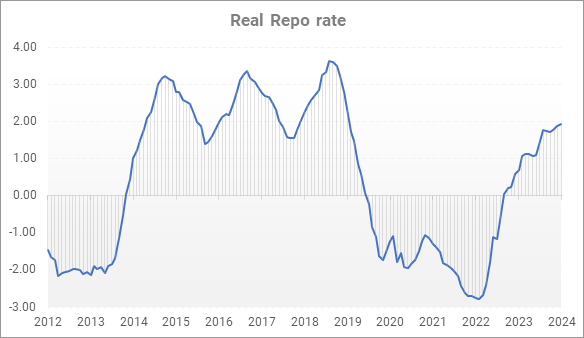
Source – Refinitiv, MOSPI, Quantum Research; Data Upto January 31, 2024
Real Policy Rate = Repo Rate – average CPI for forward 12 months. Real Rate from February 2023 to January 2024 includes Quantum Research Team’s estimates of forward CPI.
Past performance may or may not sustain in future
The RBI estimates CPI inflation to fall to average of 4.5% in FY25. However, it seemed worried about repeated food price shocks and flagged a risk of high food inflation getting generalised and pulling up non-food inflation too.
As we have highlighted earlier (Good Time to Be Bond Investor), there is no evidence of food inflation getting generalised. Despite elevated food prices, inflation expectations of Indian households have been very well anchored. As per the RBI’s inflation expectation survey, households’ perception of current inflation and expectations of future inflation have been coming down consistently.
Chart – V: Despite elevated food inflation, household inflation expectation is very well anchored
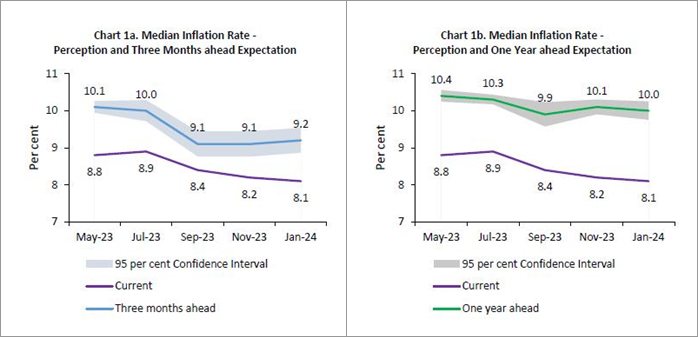
Source – RBI Households’ Inflation Expectation Survey, February 2024
Given weak employment situation, reducing fiscal support for household sector and sluggish consumption demand outlook, we see increased probability of inflation going down in future. We expect the headline CPI to average around 4.5% in FY25 with Core-CPI falling closer to 3.3% by mid-2024.
With respect to monetary policy, the RBI may wait till August before cutting interest rates. By August, we will have a fair understanding of the monsoon progress and kharif sowing trends to make reasonable assessment of the food inflation in FY25. We do see possibility of 50-100 basis points rate cut in FY25.
The Liquidity Puzzle
Going into the February monetary policy review there was an expectation from the RBI to announce liquidity support measures to infuse durable liquidity into the banking system. To the market’s disappointment the RBI seemed comfortable with the overall liquidity condition and didn’t find any reason to add liquidity. Instead, the governor in his commentary pointed that the core liquidity which adjust for the government balance, is in surplus.
Liquidity condition has tightened over the last 3-4 months with the banks’ net borrowings under the RBI’s liquidity adjustment facility rising close to Rs. 2 trillion. Much of the liquidity tightness over this period is contributed by slow pace of government spending. On an average basis, government’s surplus cash balance has been over Rs. 3 trillion since October 2023.
RBI’s liquidity assessment assumes that government will deplete its cash balance to near zero in coming months and that liquidity will make its way into the banking system.
Moreover, cash withdrawals tend to pick up between February to May period. Based on historical trend, around Rs. 2 trillion might be withdrawn from the banking system over the next four months adding further to the liquidity deficit. Thus, we expect liquidity condition to tighten significantly over the coming months. Thus short term rates will likely remain elevated in near term.
Chart – VI: Tight liquidity condition pushing short term rates higher
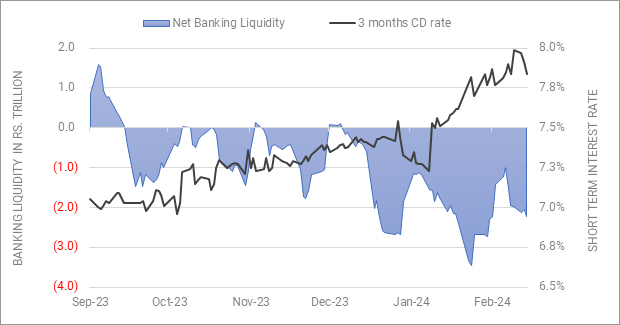
Source – RBI, Blomberg, Quantum Research; Data upto February 14, 2024
Past performance may or may not sustain in future
What should Investors do?
Considering a strong case for long term yields to decline over the next 1-2 years backed by the reasons described above, we believe long term government bonds offer a rewarding opportunity.
Dynamic Bond Funds are probably best placed to capture this opportunity with a flexibility to change if things don’t pan out as expected. However, investors need to have a longer holding period of at-least 2-3 years to ride through the intermittent volatility.
Investors with shorter investment horizons and low-risk appetites should stick with liquid funds.
Portfolio Positioning
Scheme Name | Strategy |
The scheme invests in debt securities of up to 91 days of maturity issued by the government and selected public sector companies. | |
The scheme to invest in debt securities issued by the government and selected public sector companies. The scheme follows an active duration management strategy and increases/decreases the portfolio duration (sensitivity to interest rates changes) in accordance with the Interest Rate Outlook. Given our positive view on the bond market, we are maintaining reasonably high duration in the scheme with bulk of the assets in 10-14 year maturity bucket. |
Source – RBI, Blomberg, Refinitiv, MOSPI, – IndianBudget.gov.in, CCIL, Asia Bond Monitor
For any queries directly linked to the insights and data shared in the newsletter, please reach out to the author – Pankaj Pathak, Fund Manager – Fixed Income at [email protected].
For all other queries, please contact Neeraj Kotian – Area Manager, Quantum AMC at [email protected] / [email protected] or call him on Tel: 9833289034
Read our last few Debt Market Observer write-ups -
- Good Time to Be Bond Investor
Name of the Scheme | This product is suitable for investors who are seeking* | Riskometer |
Quantum Liquid Fund An Open-ended Liquid Scheme. A relatively low interest rate risk and relatively low credit risk. |
| 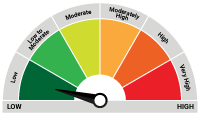 Investors understand that their principal will be at Low Risk |
Quantum Dynamic Bond Fund An Open-ended Dynamic Debt Scheme Investing Across Duration. A relatively high interest rate risk and relatively low credit risk. |
| 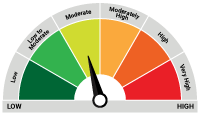 Investors understand that their principal will be at Moderate Risk |
* Investors should consult their financial advisers if in doubt about whether the product is suitable for them.
| Potential Risk Class Matrix – Quantum Dynamic Bond Fund | |||
Credit Risk → | Relatively Low | Moderate (Class B) | Relatively High (Class C) |
Interest Rate Risk↓ | |||
Relatively Low (Class I) | |||
| Moderate (Class II) | |||
| Relatively High (Class III) | A-III | ||
| Potential Risk Class Matrix – Quantum Liquid Fund | |||
Credit Risk → | Relatively Low | Moderate (Class B) | Relatively High (Class C) |
Interest Rate Risk↓ | |||
| Relatively Low (Class I) | A-I | ||
| Moderate (Class II) | |||
| Relatively High (Class III) | |||
Disclaimer, Statutory Details & Risk Factors:The views expressed here in this article / video are for general information and reading purpose only and do not constitute any guidelines and recommendations on any course of action to be followed by the reader. Quantum AMC / Quantum Mutual Fund is not guaranteeing / offering / communicating any indicative yield on investments made in the scheme(s). The views are not meant to serve as a professional guide / investment advice / intended to be an offer or solicitation for the purchase or sale of any financial product or instrument or mutual fund units for the reader. The article has been prepared on the basis of publicly available information, internally developed data and other sources believed to be reliable. Whilst no action has been solicited based upon the information provided herein, due care has been taken to ensure that the facts are accurate and views given are fair and reasonable as on date. Readers of this article should rely on information/data arising out of their own investigations and advised to seek independent professional advice and arrive at an informed decision before making any investments. Mutual fund investments are subject to market risks read all scheme related documents carefully. |
Related Posts
-

The Pivot
Posted On Friday, Apr 21, 2023
The fiscal year 2022-23 has come to an end. The defining feature
Read More -

Yield Curve Inversion Ahead
Posted On Thursday, Mar 23, 2023
Indian money markets have tightened meaningfully over the last one and a half month.
Read More -

Past, Present, and Future of Inflation
Posted On Friday, Feb 24, 2023
Inflation has been one of the biggest challenges in the post-pandemic world.
Read More




